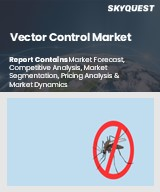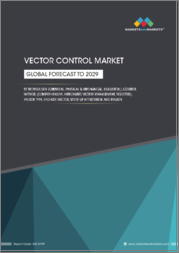
|
시장보고서
상품코드
1796501
벡터 컨트롤 시장 규모, 점유율, 성장 분석 : 기술별, 벡터 유형별, 최종사용자별, 지역별 - 산업 예측(2025-2032년)Vector Control Market Size, Share, and Growth Analysis, By Technology (Chemical, Mechanical and Physical), By Vector Type (Insects, Rodents), By End User, By Region - Industry Forecast 2025-2032 |
||||||
세계의 벡터 컨트롤 시장 규모는 2023년에 196억 달러로 평가되며, 2024년 207억 2,000만 달러에서 2032년에는 322억 8,000만 달러로 성장하며, 예측 기간(2025-2032년)의 CAGR은 5.7%로 성장할 전망입니다.
세계 벡터 제어 시장은 기후 변화, 도시화 등의 요인으로 인해 악화되는 매개체 질환의 발생률 증가에 의해 크게 견인되고 있습니다. 이러한 질병 증가로 인해 정부와 의료 시스템은 통합적인 벡터 제어 전략을 도입해야 할 필요성이 대두되고 있으며, 이는 시장 확대를 촉진하고 있습니다. 공중 보건 노력과 세계 보건 안보 프로그램은 혁신적인 기술을 통한 벡터 제어를 우선순위에 두고 있습니다. AI, 머신러닝, IoT와 같은 스마트 기술의 통합은 업무 효율성과 비용 효율성을 높입니다. 이러한 발전은 정확한 데이터 분석과 실시간 모니터링이 가능해져 대응 전략을 개선할 수 있습니다. 또한 보조금 및 생물학적 방제제 승인과 같은 규제 상황과 정부 구상은 효과적인 벡터 제어 방법의 채택을 더욱 촉진하고, 데이터 무결성 강화 및 대화형 교육 솔루션을 통해 시장 상황을 변화시킬 것입니다.
목차
서론
- 조사의 목적
- 조사 범위
- 정의
조사 방법
- 정보 조달
- 2차와 1차 데이터 방법
- 시장 규모 예측
- 시장의 전제조건과 제한
개요
- 세계 시장 전망
- 공급과 수요 동향 분석
- 부문별 기회 분석
시장 역학과 전망
- 시장 개요
- 시장 규모
- 시장 역학
- 촉진요인과 기회
- 억제요인과 과제
- Porter의 산업 분석
주요 시장 인사이트
- 주요 성공 요인
- 경쟁의 정도
- 주요 투자 기회
- 시장 에코시스템
- 시장의 매력 지수(2024년)
- PESTEL 분석
- 거시경제 지표
- 밸류체인 분석
- 가격 분석
- 사례 연구
- 고객 구매 행동 분석
벡터 컨트롤 시장 규모 : 기술별 & CAGR(2025-2032)
- 시장 개요
- 화학제품
- 기계적 및 물리적
- 생물학적
벡터 컨트롤 시장 규모 : 벡터 유형별 & CAGR(2025-2032)
- 시장 개요
- 곤충
- 설치류
벡터 컨트롤 시장 규모 : 최종사용자별 & CAGR(2025-2032)
- 시장 개요
- 주택용
- 상업용
- 농업용
- 기타
벡터 컨트롤 시장 규모 : 지역별 & CAGR(2025-2032)
- 북미
- 미국
- 캐나다
- 유럽
- 독일
- 스페인
- 프랑스
- 영국
- 이탈리아
- 기타 유럽 지역
- 아시아태평양
- 중국
- 인도
- 일본
- 한국
- 기타 아시아태평양
- 라틴아메리카
- 브라질
- 기타 라틴아메리카 지역
- 중동 및 아프리카
- GCC 국가
- 남아프리카공화국
- 기타 중동 및 아프리카
경쟁 정보
- 상위 5사의 비교
- 주요 기업의 시장 포지셔닝(2024년)
- 주요 시장 기업이 채택한 전략
- 최근 시장 동향
- 기업의 시장 점유율 분석(2024년)
- 주요 기업의 기업 개요
- 기업의 상세
- 제품 포트폴리오 분석
- 기업의 부문별 점유율 분석
- 매출의 전년대비 비교(2022-2024년)
주요 기업 개요
- Bayer AG
- BASF SE
- Syngenta AG
- FMC Corporation
- Sumitomo Chemical Co., Ltd.
- Rentokil Initial plc
- Rollins, Inc.
- Ecolab Inc.
- Bell Laboratories, Inc.
- Valent BioSciences LLC
- Clarke Mosquito Control Products, Inc.
- NEOGEN Corporation
- Nufarm Limited
- Ensystex, Inc.
결론과 제안
KSA 25.09.01Global Vector Control Market size was valued at USD 19.6 billion in 2023 and is poised to grow from USD 20.72 billion in 2024 to USD 32.28 billion by 2032, growing at a CAGR of 5.7% during the forecast period (2025-2032).
The global vector control market is significantly driven by the increasing incidence of vector-borne diseases, exacerbated by factors such as climate change and urbanization. This rise in disease prevalence compels governments and healthcare systems to incorporate integrated vector control strategies, propelling market expansion. Public health initiatives and global health security programs prioritize vector control through innovative technologies. The integration of smart technologies like AI, machine learning, and IoT enhances operational efficiency and cost-effectiveness. These advancements enable precise data analysis and real-time monitoring, improving response strategies. Additionally, regulatory support and government initiatives, such as subsidies and approval of bio-control agents, further stimulate the adoption of effective vector control methods, transforming the market landscape through enhanced data integrity and interactive training solutions.
Top-down and bottom-up approaches were used to estimate and validate the size of the Global Vector Control market and to estimate the size of various other dependent submarkets. The research methodology used to estimate the market size includes the following details: The key players in the market were identified through secondary research, and their market shares in the respective regions were determined through primary and secondary research. This entire procedure includes the study of the annual and financial reports of the top market players and extensive interviews for key insights from industry leaders such as CEOs, VPs, directors, and marketing executives. All percentage shares split, and breakdowns were determined using secondary sources and verified through Primary sources. All possible parameters that affect the markets covered in this research study have been accounted for, viewed in extensive detail, verified through primary research, and analyzed to get the final quantitative and qualitative data.
Global Vector Control Market Segments Analysis
Global Vector Control Market is segmented by Technology, Vector Type, End User and region. Based on Technology, the market is segmented into Chemical, Mechanical and Physical and Biological. Based on Vector Type, the market is segmented into Insects and Rodents. Based on End User, the market is segmented into Residential, Commercial, Agricultural and Others. Based on region, the market is segmented into North America, Europe, Asia Pacific, Latin America and Middle East & Africa.
Driver of the Global Vector Control Market
The growing incidence of vector-borne diseases like malaria, dengue, Zika virus, and chikungunya significantly propels the global vector control market. These diseases impose substantial economic strain on healthcare systems, prompting nations to prioritize investments in preventive strategies aimed at curbing disease transmission. As public awareness surrounding the critical nature of these illnesses escalates, the need for effective vector control solutions continues to rise. This heightened demand is driven by a collective effort to protect public health and ensure better management of resources in tackling the ongoing challenges posed by these pervasive diseases.
Restraints in the Global Vector Control Market
The Global Vector Control market faces notable challenges due to the high costs associated with modern solutions such as genetically modified mosquitoes, sophisticated larvicides, biological control agents, and integrated pest management systems. These innovations, while effective, can be prohibitively expensive, creating budgetary constraints for municipalities even in developed regions. Additionally, the substantial initial investments required for the research and development of effective vector control strategies pose another significant barrier to market growth. Consequently, these financial limitations hinder the broader adoption and implementation of advanced vector control methods across various geographies.
Market Trends of the Global Vector Control Market
The global vector control market is witnessing a significant trend towards the increased adoption of integrated vector management (IVM), which synergizes various control strategies to enhance effectiveness and sustainability. This approach is gaining traction as it aligns with the priorities of government health organizations and industry stakeholders, promoting a holistic solution that not only addresses immediate pest control needs but also considers long-term ecological impacts. By leveraging a combination of biological, environmental, and chemical interventions, IVM enhances the overall efficiency of vector control efforts, ensuring a balanced approach that meets public health objectives while safeguarding environmental integrity.
Table of Contents
Introduction
- Objectives of the Study
- Scope of the Report
- Definitions
Research Methodology
- Information Procurement
- Secondary & Primary Data Methods
- Market Size Estimation
- Market Assumptions & Limitations
Executive Summary
- Global Market Outlook
- Supply & Demand Trend Analysis
- Segmental Opportunity Analysis
Market Dynamics & Outlook
- Market Overview
- Market Size
- Market Dynamics
- Drivers & Opportunities
- Restraints & Challenges
- Porters Analysis
- Competitive rivalry
- Threat of substitute
- Bargaining power of buyers
- Threat of new entrants
- Bargaining power of suppliers
Key Market Insights
- Key Success Factors
- Degree of Competition
- Top Investment Pockets
- Market Ecosystem
- Market Attractiveness Index, 2024
- PESTEL Analysis
- Macro-Economic Indicators
- Value Chain Analysis
- Pricing Analysis
- Case Studies
- Customer Buying Behavior Analysis
Global Vector Control Market Size by Technology & CAGR (2025-2032)
- Market Overview
- Chemical
- Mechanical and Physical
- Biological
Global Vector Control Market Size by Vector Type & CAGR (2025-2032)
- Market Overview
- Insects
- Rodents
Global Vector Control Market Size by End User & CAGR (2025-2032)
- Market Overview
- Residential
- Commercial
- Agricultural
- Others
Global Vector Control Market Size & CAGR (2025-2032)
- North America (Technology, Vector Type, End User)
- US
- Canada
- Europe (Technology, Vector Type, End User)
- Germany
- Spain
- France
- UK
- Italy
- Rest of Europe
- Asia Pacific (Technology, Vector Type, End User)
- China
- India
- Japan
- South Korea
- Rest of Asia-Pacific
- Latin America (Technology, Vector Type, End User)
- Brazil
- Rest of Latin America
- Middle East & Africa (Technology, Vector Type, End User)
- GCC Countries
- South Africa
- Rest of Middle East & Africa
Competitive Intelligence
- Top 5 Player Comparison
- Market Positioning of Key Players, 2024
- Strategies Adopted by Key Market Players
- Recent Developments in the Market
- Company Market Share Analysis, 2024
- Company Profiles of All Key Players
- Company Details
- Product Portfolio Analysis
- Company's Segmental Share Analysis
- Revenue Y-O-Y Comparison (2022-2024)
Key Company Profiles
- Bayer AG
- Company Overview
- Business Segment Overview
- Financial Updates
- Key Developments
- BASF SE
- Company Overview
- Business Segment Overview
- Financial Updates
- Key Developments
- Syngenta AG
- Company Overview
- Business Segment Overview
- Financial Updates
- Key Developments
- FMC Corporation
- Company Overview
- Business Segment Overview
- Financial Updates
- Key Developments
- Sumitomo Chemical Co., Ltd.
- Company Overview
- Business Segment Overview
- Financial Updates
- Key Developments
- Rentokil Initial plc
- Company Overview
- Business Segment Overview
- Financial Updates
- Key Developments
- Rollins, Inc.
- Company Overview
- Business Segment Overview
- Financial Updates
- Key Developments
- Ecolab Inc.
- Company Overview
- Business Segment Overview
- Financial Updates
- Key Developments
- Bell Laboratories, Inc.
- Company Overview
- Business Segment Overview
- Financial Updates
- Key Developments
- Valent BioSciences LLC
- Company Overview
- Business Segment Overview
- Financial Updates
- Key Developments
- Clarke Mosquito Control Products, Inc.
- Company Overview
- Business Segment Overview
- Financial Updates
- Key Developments
- NEOGEN Corporation
- Company Overview
- Business Segment Overview
- Financial Updates
- Key Developments
- Nufarm Limited
- Company Overview
- Business Segment Overview
- Financial Updates
- Key Developments
- Ensystex, Inc.
- Company Overview
- Business Segment Overview
- Financial Updates
- Key Developments















